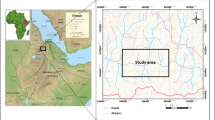Abstract
In this work, a detailed study was conducted to characterize an area selected by applying statistical methodologies for landslide susceptibility modelling of the Imera River basin (Northern Sicily). The area, classified with a very high susceptibility level, was affected by a recent landslide reactivation and it was thoroughly analyzed from the geological and geotechnical points of view. Detailed investigations were performed in the landslide, before and after its last reactivation, in order to evaluate the mechanisms (roto-translational sliding in the upper part and earth-flow in the lower part) which affected a wide and thick body of stiff and highly fissured clays belonging to the Varicolori clay Formation. Remotely sensed datasets, such as orthophotos and digital terrain models, were used for mapping the landslide processes and landforms, as well as to obtain the topographic elements useful to integrate the models into GIS software. The latter was also used for the definition of the moved soil mass after reactivation. The geological and geotechnical models were defined for 2D slope stability analyses. Back-analyses of the two sliding surfaces proved that the mobilized shear strength angle is slightly higher than the upper bound of the residual shear strength angle measured by means of direct shear tests. The obtained results prove that a multidisciplinary study like this represents a promising method for local verification of the reliability of landslide susceptibility analyses conducted at a basin scale with a purely statistical approach.
Access this chapter
Tax calculation will be finalised at checkout
Purchases are for personal use only
Similar content being viewed by others
References
Martinello, C., Cappadonia, C., Rotigliano, E.: Investigating the effects of cell size in statistical landslide susceptibility modelling for different landslide typologies: a test in central–northern sicily. Appl. Sci. 13, 1145 (2023). https://doi.org/10.3390/app13021145
Martinello, C., et al.: Investigating limits in exploiting assembled landslide inventories for calibrating regional susceptibility models: a test in volcanic areas of el salvador. Appl. Sci. 12, 6151 (2022)
Cafiso, F., Cappadonia, C., Ferraro, R., Martinello, C.: Rockfall hazard assessment of the monte gallo oriented nature reserve area (Southern Italy). In: Proceedings of the IOP Conference Series: Earth and Environmental Science, Beijing, China, 6 September 2021, vol. 833. IOP Publishing Ltd., Bristol (2021)
Cappadonia, C., Cafiso, F., Ferraro, R., Martinello, C., Rotigliano, E.: Rockfall hazards of mount pellegrino area (Sicily, Southern Italy). J. Maps 17, 29–39 (2021)
Brabb, E.E.: The world landslide problem. Episodes 14, 52–61 (1991). https://doi.org/10.18814/epiiugs/1991/v14i1/008
Martinello, C., Cappadonia, C., Conoscenti, C., Agnesi, V., Rotigliano, E.: Optimal slope units partitioning in landslide susceptibility mapping. J. Maps 17, 152–162 (2021)
Azzaro, R., et al.: The earthquake of 6 September 2002 and the seismic history of Palermo (Northern Sicily – Italy): implications for the seismic hazard assessment of the city. J. Seismol. 8(4), 525–543 (2004)
Agnesi, V., et al.: A multidisciplinary approach to the evaluation of the mechanism that triggered the Cerda landslide (Sicily, Italy). Geomorphology 65(1–2), 101–116 (2005)
Bonci, C., et al.: Geological control on large seismically induced landslides: the case of Cerda (Southern Italy). In: Lacerda, W., Ehrlich, M., Fontoura, S.A.B., Sayao, A.S.F. (eds.) Landslides: Evaluation and Stabilization, pp. 985–991. Taylor and Francis Group, London (2004)
Bozzano, F., Cet al.: Engineering-Geology model of the seismically-induced cerda landslide. Bollettino Geofisica Teorica Appl. 49, 205–226 (2008)
Rosone, M., Ziccarelli, M., Ferrari, A., Farulla, C.A.: On the reactivation of a large landslide induced by rainfall in highly fissured clays. Eng. Geol. 235, 20–38 (2018)
Rosone, M., Ziccarelli, M., Ferrari, A.: Displacement evolution of a large landslide in a highly fissured clay. Lect. Notes Civ. Eng. 40, 195–204 (2020)
Martinello, C., Cappadonia, C., Conoscenti, C., Rotigliano, E.: Landform classification: a high-performing mapping unit partitioning tool for landslide susceptibility assessment—a test in the Imera River Basin (Northern Sicily, Italy). Landslides 19, 539–553 (2022)
Friedman, J.H.: Multivariate adaptive regression splines. Ann. Stat. 19, 1–67 (1991)
Mandaglio, M.C., Moraci, N., Rosone, M., Airò Farulla, C.: Experimental study of a naturally weathered stiff clay. Can. Geotech. J. 53(12), 2047–2057 (2016)
Rosone, M., Ferrari, A., Ziccarelli, M., Giger, S.B.: The residual shear strength of the shaly and sandy facies of the opalinus clay. In: Ferrari, A., Laloui, L. (eds.) SEG 2018. SSGG, pp. 426–433. Springer, Cham (2019). https://doi.org/10.1007/978-3-319-99670-7_53
Rosone, M., Megna, B., Celauro, C.: Analysis of the chemical and microstructural modifications effects on the hydro-mechanical behaviour of a lime-treated clay. Int. J. Geotech. Eng. 15, 447–460 (2021)
Ferrari, A., Rosone, M., Ziccarelli, M., Giger, S.B.: The shear strength of Opalinus Clay shale in the remoulded state. Geomech. Energy Environ. 21, 100142 (2020)
Airò Farulla, C., Cafiso, F., Calvi, F., Rosone, M.: Safeguarding historic towns on hilltops threatened by land sliding: the case of San Fratello in Sicily. Ital. Geotech. 49(1), 7–28 (2015)
Ferrari, A., Ledesma, A., Gonzàlez, D.A., Corominas, J.: Effects of the foot evolution on the behaviour of slow-moving landslides. Eng. Geol. 117(3–4), 217–2228 (2011)
Author information
Authors and Affiliations
Corresponding author
Editor information
Editors and Affiliations
Rights and permissions
Copyright information
© 2023 The Author(s), under exclusive license to Springer Nature Switzerland AG
About this paper
Cite this paper
Martinello, C., Rosone, M., Cappadonia, C., Mineo, G. (2023). Multidisciplinary Study on a Landslide Area Individuated by Using Statistical Methodologies Before and After the Last Reactivation. In: Ferrari, A., Rosone, M., Ziccarelli, M., Gottardi, G. (eds) Geotechnical Engineering in the Digital and Technological Innovation Era. CNRIG 2023. Springer Series in Geomechanics and Geoengineering. Springer, Cham. https://doi.org/10.1007/978-3-031-34761-0_28
Download citation
DOI: https://doi.org/10.1007/978-3-031-34761-0_28
Published:
Publisher Name: Springer, Cham
Print ISBN: 978-3-031-34760-3
Online ISBN: 978-3-031-34761-0
eBook Packages: EngineeringEngineering (R0)




